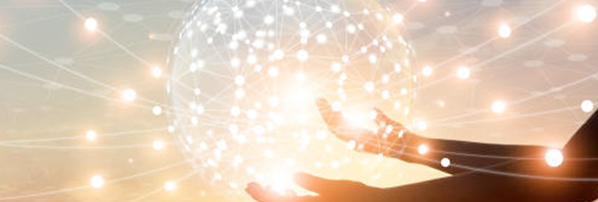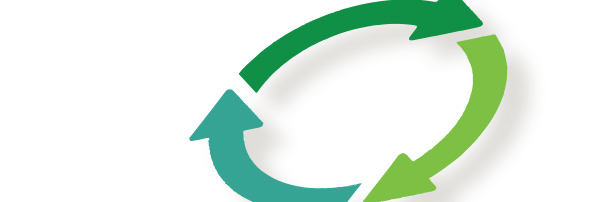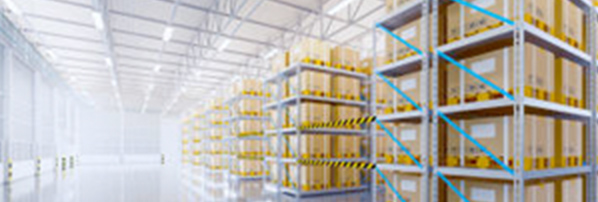Decarbonization and a Recycling-based Society
Environmental Management
Policy and structure
Environmental policy statement
SECOM positions “decarbonization and a recycling-based society” as one of its priority materiality themes. In October 2022, SECOM significantly revised its basic environmental policy as the SECOM Group Environmental Policy, which more clearly states its basic stance of contributing to resolving global environmental issues through business.
SECOM shares the Policy throughout the entire group as a compass for our environmental protection activities.
Structure
The President and Representative Director is responsible for the risks and opportunities related to climate change throughout the Group.
In its daily activities, the Sustainability Promotion Office plays a central role in promoting environmental conservation activities for the entire Group, under the leadership of the Director in charge of sustainability.
Specifically, it plans and implements environmental measures, confirms trends in energy-saving technologies, and calculates greenhouse gas emissions (Scope 1, 2, and 3). It gathers information on TCFD recommendations, SBT, RE100, and other climate-related issues and energy-saving technologies, total CO2 emission limits and emission trading systems, renewable energy prices, and environmental laws and regulations, etc. In addition, it cooperates with the environmental, CSR, and business-planning managers of every Group company to evaluate various short-, medium-, and long-term climate-related risks.
Environmental management chart
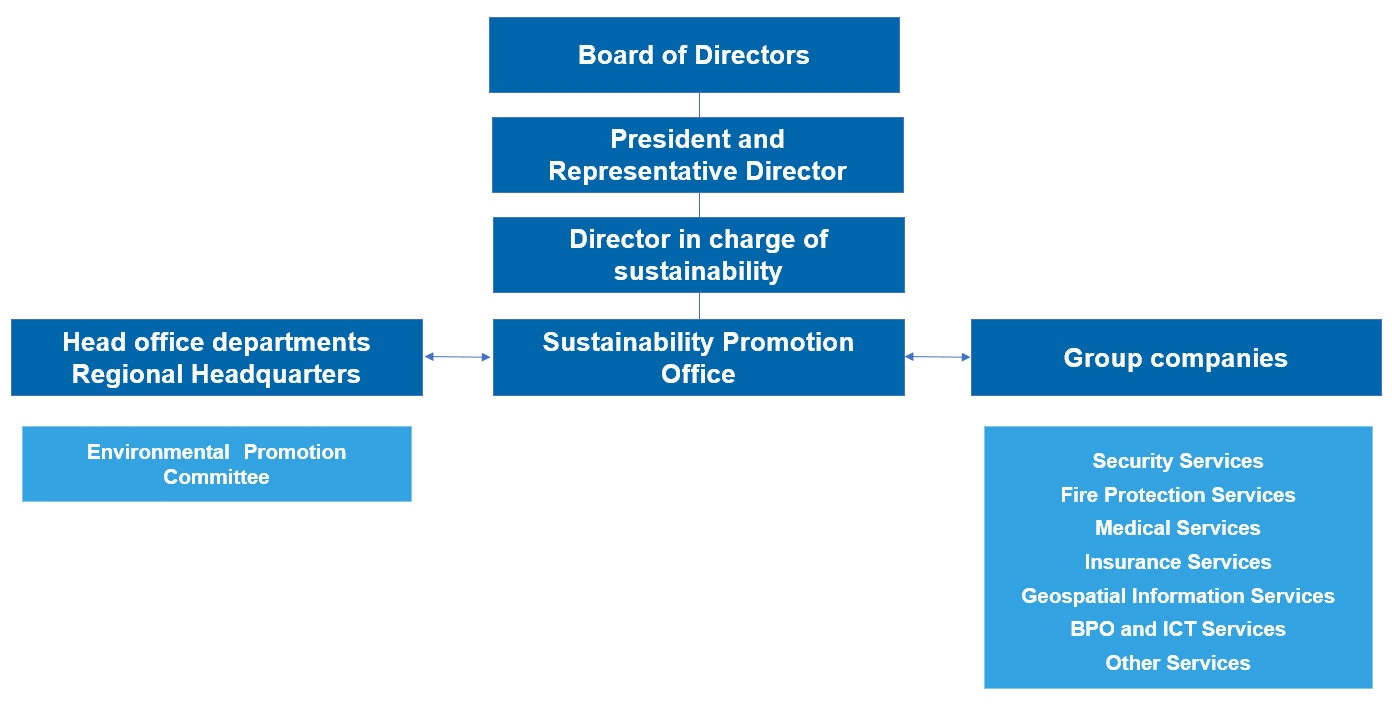
Acquired environmental management system certification
The SECOM Group operates an environmental management system (ISO 14001*) at the companies and workplaces listed below. In order to promote continuous environmental conservation activities at other workplaces, we established the Environmental Promotion Committee to plan (Plan), implement and operate (Do), evaluate (Check), and improve (Act). In this way, the PDCA cycle is continuously operated to reduce environmental impact.
* ISO 14001: An international standard for environmental management established by ISO (International Organization for Standardization).
- Secom Industries Co., Ltd. (November 1999)
- SECOM CO., LTD. (December 2000)
- Nohmi Bosai Ltd. (August 2001)
- Pasco Corp. (February 2003)
- Nittan Co., Ltd. (February 2004)
- Asahi Security Co., Ltd. (December 2008)
- Secom Technical Services Pty. Ltd. (April 2012)
- Secom Plc (April 2014)
- Secom Australia Pty. Ltd. (August 2020)
- Shanghai Nohmi Secom Fire Protection Equipment Co., Ltd. (July 2021)
- Scan Alarms & Security Systems (UK) Ltd. (June 2023)
Compliance with environmental laws
Following the spirit of legal compliance as listed in our environmental policy, the SECOM Group responds appropriately to environmental laws and ordinances.
Major environmental laws and ordinances include:
- Act on the Rational Use of Energy
- Act on Promotion of Global Warming Countermeasures
- Act on Rational Use and Proper Management of Fluorocarbons
- Waste Management and Public Cleansing Act
- Automobile Nitrogen Oxides–Particulate Matter Law
- Environmental ordinances in 10 municipalities (prefectures and government-designated cities) in Japan
- Tokyo Metropolitan Environmental Security Ordinance (Cap and Trade System)
Overseeing environmental performance
Environmental management key performance indicators
Following its environmental policy, the SECOM Group promotes activities for sustainable development in consideration of the global environment in all its business activities. We evaluate and manage the progress and achievement of our environmental conservation activities based on the following seven major environmental management indicators.
- Greenhouse gas emissions (Scope 1 and 2)
- Greenhouse gas emissions across the supply chain (Scope 3)
- Reduction of greenhouse gas emissions as against base year (%)
- CO2 emissions per unit of production (emissions intensity)
- Electricity used and the percentage thereof accounted for by electricity generated from renewable energy
- Consumption of fuel by vehicles and percentage of vehicles replaced by electric models
- Resources with market value/recycled resources and industrial waste
Scope 1: Direct emissions (gasoline/petrol, diesel, kerosene, etc.)
Scope 2: Indirect emissions (electricity, cold/hot water, etc.)
Scope 3: Indirect emissions other than Scope 1 and 2 (emissions from the activities of other companies up and down the supply chain)
Responses to TCFD recommendations
In June 2019, we declared our support for the Task Force on Climate-related Financial Disclosures (TCFD), in view of the importance of active corporate action and disclosure of information related to climate change.
We recognize a variety of risks and opportunities related to climate change. We acknowledge that risks pertaining to fluctuations in the price of fuel consumed by vehicles used in our security services business and the introduction of a carbon tax, as well as to the impact of climate change on our nonlife insurance and data center service businesses, will increase. At the same time, we also understand that shifting customer needs will yield opportunities to expand demand for new services. Accordingly, we promote strategies that seek to capitalize on opportunities while remaining mindful of the potential impact of risks on our operations.
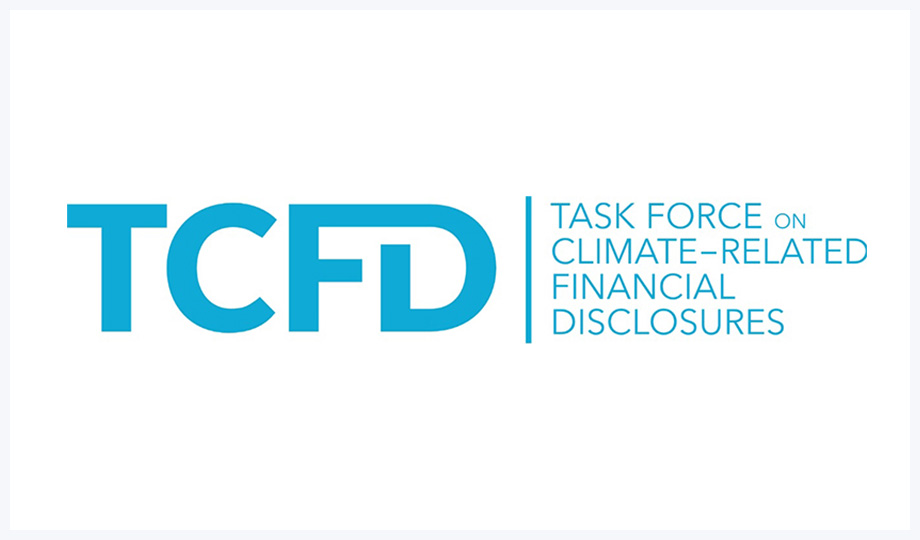
Climate-related risk identification and management processes
The SECOM Group works in business areas such as security services, data center services, and medical services where it is important to provide services stably and continuously. We have worked on company-wide risk management to ensure the continuity of our service systems.
We have established the Risk Countermeasures Committee to perform companywide risk assessment and consider countermeasures for risks with the potential to affect the business services offered by the Group. The committee is chaired by the director in charge of risk management and composed of managers from major departments at the head office. Utilizing the results of companywide surveys, the committee identifies and evaluates risks from the viewpoints of scope of impacts, scale, assumed financial damage, urgency, and frequency of occurrence. For example, corporate value, service provision, and life/safety are prioritized for cases that are less frequent but cause more damage.
Risk survey analysis chart
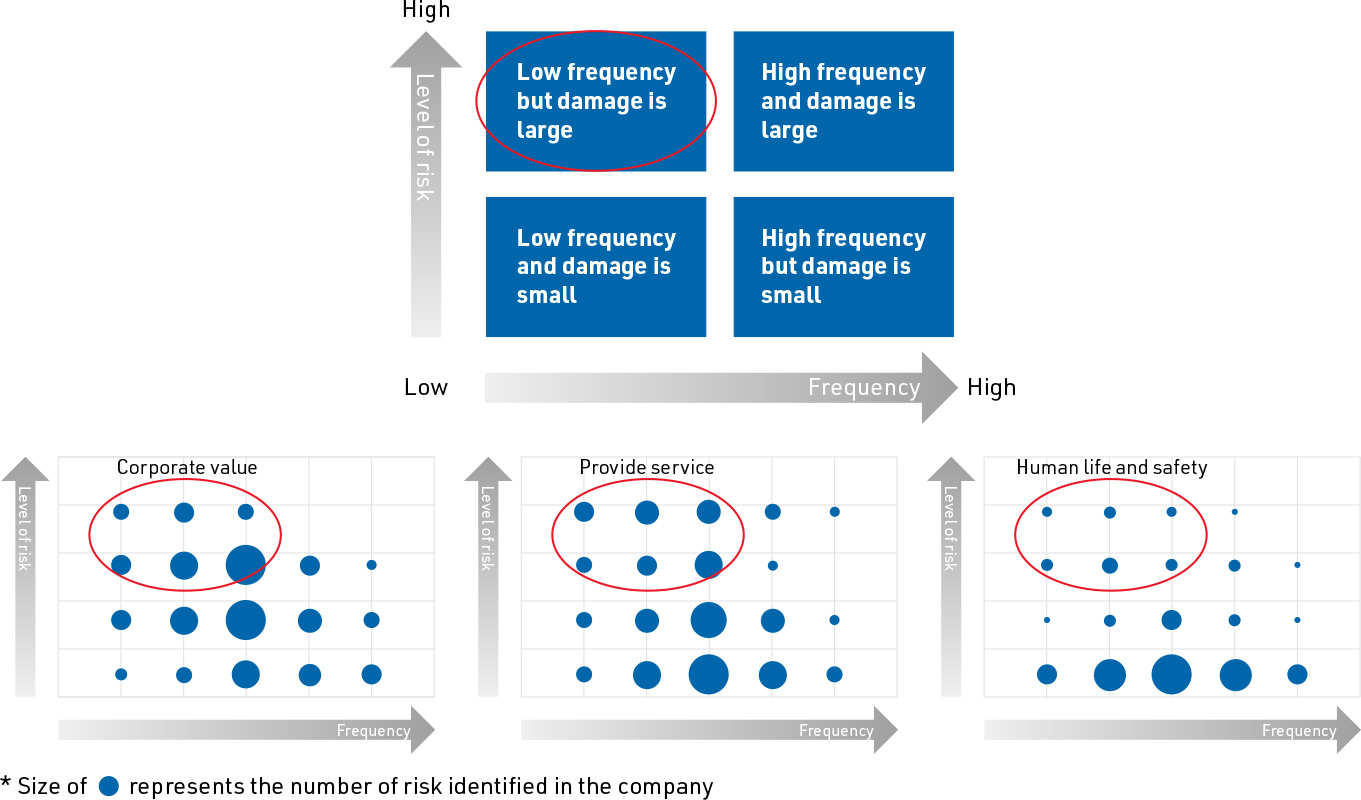
Risks subject to analysis and evaluation are classified into: (1) Large-scale calamity risk (earthquakes, wind, flood, volcanic disasters, radiation leakage, etc.), (2) Compliance risk, (3) System risk, (4) Service providing risk, (5) Administrative work and accounting risk, (6) Supply chain risk, (7) Infection risk, (8) SDGs related risk. Climate change-related risks are also analyzed, evaluated, and handled in this risk management process. These management considerations are regularly reported by the President and Representative Director to the Board of Directors depending on the level of importance.
One issue occurring with greater frequency in recent years is large-scale natural disasters. In preparation for large-scale natural disasters caused by climate change, we have established countermeasures for minimizing damage to SECOM itself, allowing us to provide stable and uninterrupted services, using measures such as establishing a disaster task force, securing methods for collecting information about damage status, and understanding the impact on systems that provide services to customers.
Climate-related risks and opportunities
Because the SECOM Group uses approximately 9,000 four-wheeled vehicles, we are subject to the risk of fluctuations in the unit prices of fuels such as gasoline and diesel oil, as well as risks related to rises in energy-related costs such as carbon taxes and emission-trading system costs. While the insurance services segment and data center services have increased risks related to climate change, we recognize that they are also associated with tremendous opportunities, in line with achieving a decarbonization society. We will implement strategies that understand the impact of climate change on our business activities and take advantage of these opportunities.
As shown below, we have analyzed the climate-related risks and opportunities that we expect to have an impact on the Group's business activities. These risks and opportunities were evaluated in terms of their financial impact and divided into three categories: high, medium and low.
Materiality matrix
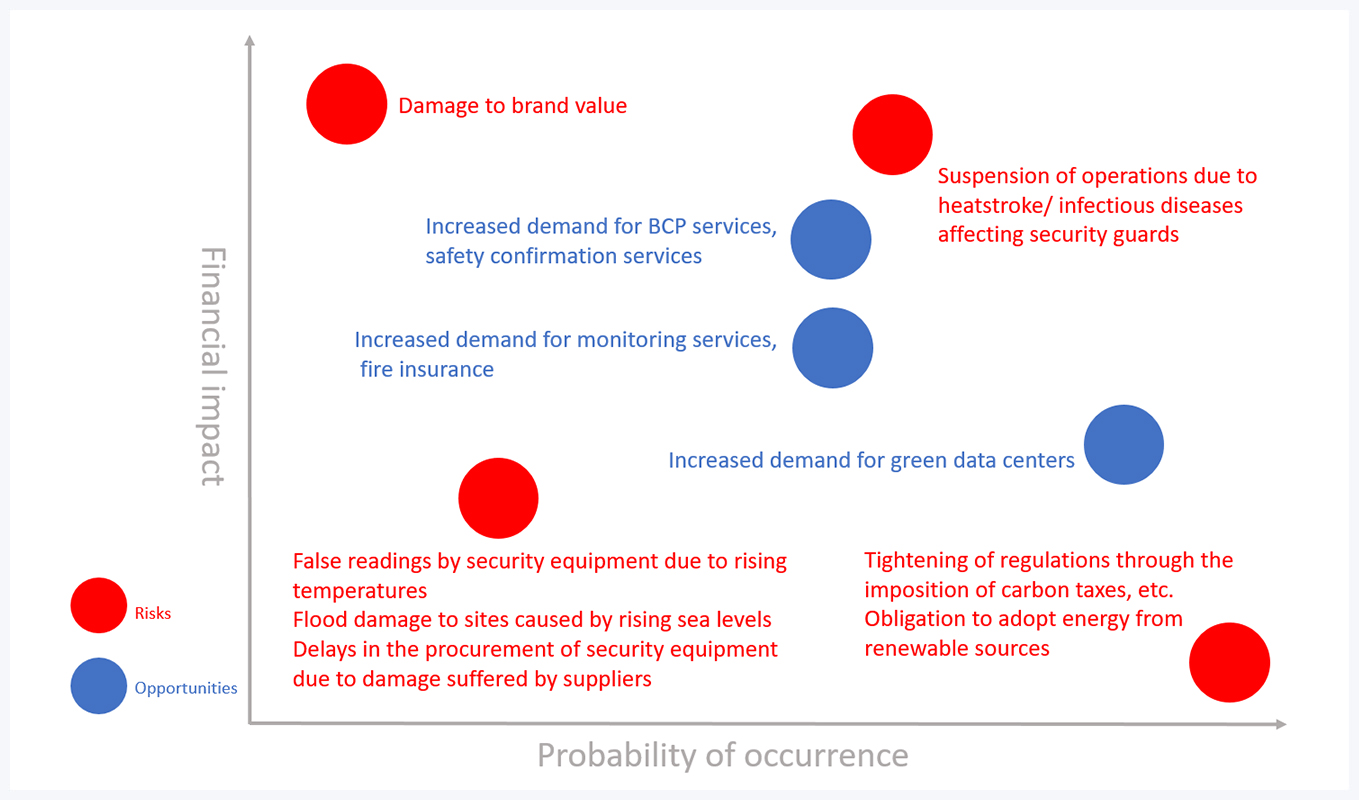
〈Risks〉
| Type | Critical issues | Details | Financial impacts |
|---|---|---|---|
| Physical risks | Suspension of operations due to heatstroke/infectious diseases affecting security guards |
The global warming resulting from climate change is growing more and more severe, and rising temperatures are one of the chronic physical risks in Japan, where the high temperature in summer is frequently the highest ever recorded. This rise in temperature is expected to continue. Under SECOM's on-line security contracts, we provide around-the-clock emergency services, dispatching emergency response personnel to sites when an alert is received. During the summer, these personnel may be subject to a higher risk of heatstroke. This leads to higher costs for heatstroke countermeasures and can result in delays in going on-site during emergency dispatches. If the situation becomes more severe, it could also lead to violations of laws such as the Security Services Act, resulting in the suspension of operations due to administrative sanctions, damage to our brand image, damage to our trustworthiness and other major risks. |
High |
| Physical risks |
False readings by security equipment due to rising temperatures Flood damage to sites caused by rising sea levels Delays in the procurement of security equipment due to damage suffered by suppliers |
The cost of disaster countermeasures related to climate change-related adaptation is increasing continuously. In the event of a large-scale natural disaster, a large amount of resources is required for business continuity, such as confirming the safety of contractors and replacing damaged equipment. This increases recovery costs. Security devices and surveillance cameras are precision devices. If they are affected by abnormally high temperatures, direct sunlight, or lightning strikes, their sensitivity and durability may be impaired. As measures against these risks, we continue to improve equipment performance and develop new technologies, but the cost of equipment may increase if temperatures rise significantly. The Group's BPO and ICT services primarily consist of data center business, in which we centrally manage information and communications systems. To stably operate critical computers (servers) around the clock, we work in highly robust buildings that are prepared for the possibility of natural disasters, and we operate high reliability power-receiving systems, efficient cooling systems and stringent security systems. We delegate the installation work of our security equipment to partner companies. If natural disasters caused by global warming frequently occur or restrictions on going out due to pandemics become widespread, the procurement and installation work of the security equipment we provide to customers may be delayed. |
High |
| Transition risks |
Tightening of regulations through the imposition of carbon taxes, etc. Obligation to adopt energy from renewable sources |
There is the risk that if the tax rate of the Global Warming Countermeasures Tax (Japan Carbon Tax) is raised to the level of Europe and the United States, the unit price of gasoline and diesel oil will be affected, leading to increased energy costs. In addition, while the demand for renewable energy is increasing gradually, there is the financial risk that if there is a shortage of domestic renewable energy supply, the unit price of zero-carbon power may rise and it may become difficult to procure renewable energy. | Medium |
| Transition risks | Damage to brand value | Brand power is one of the important corporate values for SECOM. If society views SECOM negatively in terms of its attitude toward global warming countermeasures and environmental issues, it may have a profound impact on the business. | High |
〈Opportunities〉
| Type | Critical issues | Details | Financial impacts |
|---|---|---|---|
| Products and services | Increased demand for BCP services, safety confirmation services |
If weather phenomena become severe due to the effects of global warming and social infrastructure such as power, communications, and transportation frequently stop functioning, it is expected that there will be a stronger need for BCP supports such as safety measures for company buildings and facilities, confirmation of employee safety, and information security. Furthermore, we offer many services and products that meet growing needs for BCP-related services for customers who are working to reduce their greenhouse gas emissions under increasingly strict environmental regulations. Notably, our System Security AZ has functions for automated facility control integrated with security, helping reduce wasteful power consumption. Our Secure Data Center protects our customers' information assets. Our Facility Management Service provides comprehensive management for asset information while conserving energy, and our Safety Confirmation Service enables subscribers to ascertain the safety of employees in the event of a disaster. |
High |
| Products and services | Increased demand for monitoring services,fire insurance |
As global warming caused by climate change continues, there is a risk of permafrost melting and pathogens which were previously trapped in the ice being released. Also, global warming may expand the habitat and increase the population of mosquitoes, which are vectors for malaria and dengue fever. If a viral or other infectious disease pandemic occurs, we expect to see a growing demand for services that reduce interpersonal physical contact, such as our Virtual Keibi System or our cocobo security robot. The growing number of elderly people living alone has become a social problem in Japan, which is a super-graying society. In addition to SECOM's home security services, this change will provide us with opportunities to expand sales of Mago Channel with SECOM, which allows users to check the situation in the homes of family members living far away via their smartphones, and SECOM Monitoring Service for Seniors, a service that supplements security and monitoring services by dispatching SECOM personnel on-site in the event of an emergency. Furthermore, people's needs for disaster countermeasures are becoming increasingly apparent, and we expect to see a rise in non-life insurance premiums and enrollment in new non-life insurance policies. Secom General Insurance Co., Ltd. sells fire insurance that covers losses caused by natural disasters in Japan, so we will aim to expand sales by leveraging synergetic effects by bundling security contracts and fire insurance. |
High |
| Products and services | Increased demand for green data centers |
In our data center business, which integrates and centralizes information and communications systems, we have installed high-reliability power-receiving systems and air-conditioning systems to efficiently cool devices in our robust buildings that are resistant to natural disasters, to ensure that critical computers (servers) can continue to operate stably around the clock. If the risk of natural disasters increases due to higher temperatures, we predict a rise in demand for large-scale data centers, which offer safety, reliability and a high level of efficiency. Data centers consume a large amount of electricity, so there are increasing demands from customers to use renewable energy. We recognize such customer needs and have begun offering services that enable customers to switch the electricity they use to options with net zero CO2 emissions. In the future, we expect to see not only an increase in the use of large-scale data centers with exceptional energy-saving performance but also an increase in demand for decarbonization services. |
High |
Scenario analysis
The TCFD recommendations require companies to conduct multiple scenario analyses and disclose the financial impacts of climate change on their future business activities. Even though climate change has little impact on SECOM's current financial data, it may have a large impact in the medium to long term. We are analyzing risks and opportunities based on the IEA450 scenario*1 and NDCs scenario*2.
The IEA450 scenario assumes a future society where electric and fuel cell vehicles become more widespread. Since the SECOM Group uses approximately 9,000 four-wheeled vehicles and consumes roughly 20,000 KL of vehicle fuel per year, vehicle-related matters have a relatively large impact on our services. Replacing our ICE vehicles with electric vehicles means that installation costs for charging facilities, high-voltage power contracts, and vehicle-leasing fees will increase. Since many of our offices are rental properties, the development of social infrastructure, such as the widespread use of charging stations, including those at rental buildings, is an important requirement.
To reduce greenhouse gas emissions, regulations such as carbon taxes, total greenhouse gas emission regulations, and emission-trading systems are likely to be strengthened. If the current Global Warming Countermeasures Tax (Japan Carbon Tax) of ¥289/ton is increased to ¥10,000/ton, our annual cost will increase.
Security devices and surveillance cameras are precision devices. If they are affected by abnormally high temperatures, direct sunlight, or lightning strikes, their sensitivity and durability may be impaired. As measures against these risks, we continue to improve equipment performance and develop equipment with new technologies, but the cost of equipment may increase, especially in the NDCs scenario, in which global warming mitigation measures progress slowly.
PASCO Corporation, a Group company, uses aircraft, optical satellites, and synthetic-aperture radar satellites that can collect surface information even in rainy weather to obtain geographic information based on measurement and analysis technology. From this data, the company offers services based on an understanding of the status of earthquakes, tsunamis, typhoons, and volcanic activities that occur frequently on a global scale. The company also offers monitoring and damage prediction services for sea level rise and glacial lake expansion, etc. There are opportunities for us to expand our business by providing new services that address climate change, such as by applying the proprietary technologies that PASCO has developed. We could then analyze information collected from drones to create 3D data for disaster prevention.
The data centers run by the SECOM Group are certified as either Platinum (the highest level) or Gold (the next highest level) under the US Green Building Council's LEED-CS environmental certification. They are also certified by the Tokyo Metropolitan Government as Outstanding Specified Global Warming Countermeasure Facilities. Data center services are a major source of CO2 emissions. We therefore expect that companies and local governments that are highly focused on environmental protection will require extremely efficient services with low environmental impact while ensuring data security. We believe that there is a significant business opportunity owing to SECOM's latest facilities and accumulated management know-how.
Currently, our main focus is on qualitative analysis of the risks and opportunities in each business segment, but we will continue to strive to understand the latest external scenarios and aim for quantitative analysis and information disclosure based on multiple scenarios.
*1 IEA450 scenario: A typical 2°C scenario created by the International Energy Agency.
*2 NDCs scenario: A scenario in which nationally determined contributions are achieved under the Paris Agreement. The world's average temperature is expected to rise by about 3°C.

